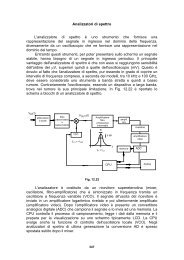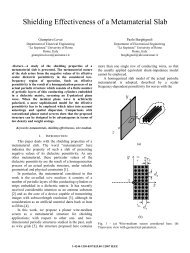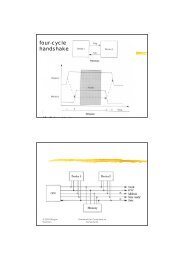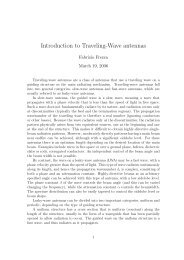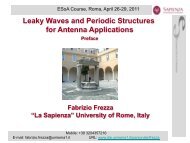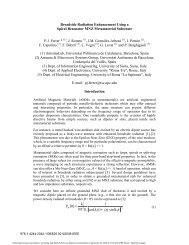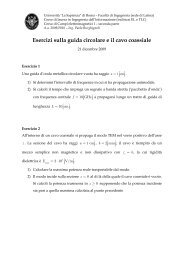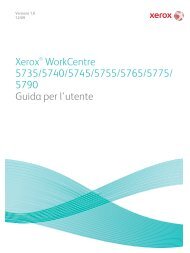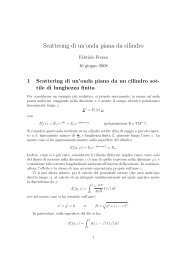A fast analytical approximated method <strong>of</strong> solution for RTE,based on the generalization <strong>of</strong> the Ed<strong>di</strong>ngton approximationand capable to unfold the azimuthal dependence <strong>of</strong> thera<strong>di</strong>ance field, has been developed [17], [18]. Performances <strong>of</strong>this new ra<strong>di</strong>ative model, named GERM (GeneralizedEd<strong>di</strong>ngton Ra<strong>di</strong>ative Model), in simulating the backscattered(reflected) and forwarded (transmitted) intensity field due to aplane- parallel homogeneous me<strong>di</strong>um, have been evaluated bycomparison with the “exact” DISORT numerical model. Themain theoretical limitations <strong>of</strong> GERM are related to theassumption <strong>of</strong>: i) stratified me<strong>di</strong>um geometry; ii) unpolarizedra<strong>di</strong>ation. A way to apply GERM to a 3-D problem is to resortto a 1-D slant geometry along the viewing angle, that is toconstruct an equivalent 1-D problem from the given 3-D one.The limitation due to the hypothesis <strong>of</strong> unpolarized ra<strong>di</strong>ancecan be only removed if the elements <strong>of</strong> the rotated phasematrix can be approximated by means <strong>of</strong> a Sobolev phasefunction [16]. The vali<strong>di</strong>ty <strong>of</strong> this approximation would, <strong>of</strong>course, depend on the properties <strong>of</strong> the particle <strong>di</strong>stributionPreliminary GERM numerical results are shown in Fig. 6 interms <strong>of</strong> percentage fractional error, with respect to DISORToutputs, as a function <strong>of</strong> optical thickness and volumetricalbedo for asymmetry scattering factor g. The percentageerror is less than 10% on average, being higher for largeralbedo and optical thickness.IV. PRELIMINARY MEASUREMENTSPreliminary measurements, carried out in Rome using the<strong>FSO</strong> link illustrated in Sect. II, are shown here. The temporaltrend <strong>of</strong> temperature and humi<strong>di</strong>ty for an event with moderatestratiform rain with some embedded convection is shown inFig. 7. The coupled <strong>FSO</strong>/meteorological measurements spanbetween December 14 and 15, 2010 and clearly evidences theanti-correlation between thermal and wet characteristics <strong>of</strong> theatmosphere.For the considered winter event Fig. 8 shows the sametemporal trend <strong>of</strong> Fig. 7, but for the measured rainfall andreceived power at 1550 nm. The received power is anticorrelatedwith rain intensity: when the latter increases, thereceived power decreases and viceversa. Fig. 9 shows themeasured path attenuation, derived from the received power inFig. 8, and the pre<strong>di</strong>cted rain specific attenuation, derivedfrom the semi-empirical model (3). There is a good agreementin terms <strong>of</strong> value range, even though a certain <strong>di</strong>spersion isnoted probably due to the raingauge sensitivity (about 0.2mm/h). Further analysis is needed to investigate themeasurement quality and test attenuation pre<strong>di</strong>ction models.2520Precipitationrain [mm/h]1510500 5 10 15 20 25 30 35 40 45 50time [h]90Received power [W]80706050403020100 5 10 15 20 25 30 35 40 45 50time [h]Fig. 8. Same as in Fig. 7, but for rain (mm/h) and received power (W).Fig. 7. Temporal trend <strong>of</strong> temperature (K) and relative humi<strong>di</strong>ty (%) overa period <strong>of</strong> 50 hours on Dec. 14-15, 2010 in Rome (Italy).V. CONCLUSIONSThe activity devoted to the deployment <strong>of</strong> a new free spaceoptics (<strong>FSO</strong>) link set up in Rome (Italy) has been illustrated.
The two-way optical link at 1550 nm is about 1 km long andcan operate with a transmission rate up 1.5 Gbps. Among dust,precipitation, turbulence, fog, and any flying objects affectingthe capacity <strong>of</strong> the optical channel, a focus has been placed onwater particle effects (fog and rain). A numerical evaluation <strong>of</strong>these atmospheric effects has been illustrated, together with apreliminary <strong>FSO</strong> channel modelling based on semi-empiricalpre<strong>di</strong>ction models and the ra<strong>di</strong>ative transfer theory. The latterframework can, in principle, take into account multiplescattering effects along the <strong>FSO</strong> path.Further activity will be devoted to assess data quality,collect long time series in various meteorological scenariosand optimize the attenuation pre<strong>di</strong>ction models.Path attenuation [dB]Specific attenuation Rain[dB/km]54.543.532.521.510.5<strong>FSO</strong> Measured average path attenuation at 1550 nm00 5 10 15 20 25 30 35 40 45 50time [h]654321Rain specific attenuation pre<strong>di</strong>ction at 1550 nm00 5 10 15 20 25 30 35 40 45 50time [h]Fig. 9. Same as in Fig. 7, but for <strong>FSO</strong> measured path attenuation (dB) andrain pre<strong>di</strong>cted specific attenuation (dB/km), from expression (3).ACKNOWLEDGMENTThe authors deeply thank the staff <strong>of</strong> CommunicationsDepartment ISCTI (Italy) for the technical support. ISCTI isgreatly acknowledged for sponsoring the fellowship <strong>of</strong> one <strong>of</strong>the authors (SM).REFERENCES[1] X. Zhu and J. M. Kahn, “Free-space optical communication throughatmospheric turbulence channels,” IEEE Trans. Commun., vol. 50, pp.1293–1300, 2002.[2] A.K. Majumdar and J.C. Ricklin Free-Space Laser Communications,Principles and Advantages. Springer Science LLC, 233 Spring Street,New York, NY 10013, U.S.A., 2008.[3] T. H. Carbonneau and D. R. Wisley, ”Opportunities and challenges foroptical wireless; the competitive advantage <strong>of</strong> free spacetelecommunications links in today’s crowded market place”, SPIEConference on Optical Wireless Communications, Massachusetts, pp-119-128, 1998.[4] M. D’Amico, A. Leva, and B. Micheli, “Free-Space OpticsCommunication Systems: First Results From a Pilot Field-Trial in theSurroun<strong>di</strong>ng Area <strong>of</strong> Milan, Italy”, IEEE Microwave and wirelessComponents Letters, vol. 13, pp. 305-307, 2003.[5] R. Nebuloni, “Empirical relationships between extinction coefficientand visibility in fog”, Applied Optics, vol. 44, pp. 3795-3804, 2005.[6] M.S. Awan, R. Nebuloni, Carlo Capsoni, L. Csurgai-Horva, S.S.Muhammad, F. Nadeem, M.S. Khan, and E. Leitgeb, “Pre<strong>di</strong>ction <strong>of</strong>drop size <strong>di</strong>stribution parameters for optical wireless communicationsthrough moderate continental fog”, .Int. J. Sat Comm. Networking, DOI:10.1002/sat.950, 2010.[7] F. Nadeem, V. Kvicera, M.S. Awan, E. Leitgeb, S.S. Muhammad, andG. Kandus, “Weather Effects on Hybrid <strong>FSO</strong>/RF CommunicationLink”, IEEE Journal on Selected Areas In Communications, vol. 27,pp.1687-1697, 2009.[8] A. Ishimaru, Wave propagation and scattering in random me<strong>di</strong>a,(IEEE Press, Piscataway, NJ, 1997.[9] S. Sheikh Muhammad, B. Flecker, E. Leitgeb, and M. Gebhart,”Characterization <strong>of</strong> Fog Attenuation in Terrestrial Free Space OpticalLinks”, J. Optical Eng., vol. 46(6) pp. 066001-1 -06601-10, June 2007.[10] P. W. Kruse et. al., Elements <strong>of</strong> Infrared Technology: Generation,Transmission and Detection, J. Wiley and Sons, New York 1962.[11] I. Kim, B. McArthur, and E. Korevaar, ”Comparison <strong>of</strong> Laser BeamPropagation at 785 and 1550 nm in Fog and Haze for Optical WirelessCommunications”, Proc. SPIE, vol. 4214, pp.26-37, 2001.[12] M. Al Naboulsi, H. Sizun, and F. de Fornel, ”Fog AttenuationPre<strong>di</strong>ction for Optical and Infrared Waves”, Optical Eng., vol. 43(2),pp. 319-329, 2004.[13] F.S. Marzano, D. Scaranari, and G. Vulpiani, “Supervised fuzzy-logicclassification <strong>of</strong> hydrometeors using C-band dual-polarized radars”,IEEE Trans. Geosci. Rem. Sensing, n. 45, pp. 3784-3799, 2007.[14] W.G. Tam and A. Zardecki, “Multiple scattering corrections to theBeer–Lambert law. 1. Open detector”, Appl. Opt., vol. 21, pp. 2405–2412, 1982.[15] F.S. Marzano and L. Roberti, “Numerical investigation <strong>of</strong> intenserainfall effects on coherent and incoherent slant-path propagation at Kband and above,” IEEE Trans. Ant. Propagat., vol. 28, pp. 51-69, 2003.[16] E.P. Shettle and J.A. Weinman, “The transfer <strong>of</strong> solar irra<strong>di</strong>ancethrough inhomogeneous turbid atmospheres evaluated by Ed<strong>di</strong>ngton’sapproximation,” J. Atm. Sci., vol. 27, pp. 1048-1055, 1970.[17] F.S. Marzano and G. Ferrauto, “Generalized Ed<strong>di</strong>ngton analyticalmodel <strong>of</strong> azimuthally-dependent ra<strong>di</strong>ance simulation in stratifiedme<strong>di</strong>a”, Appl. Opt., vol. 44, pp. 6032-6048, 2005.[18] F.S. Marzano and G.M. Tosi Beleffi, “An analytical multiple scatteringmodel to characterize free-space millimeter-wave and optical links inpresence <strong>of</strong> atmospheric impairments”, Proc. <strong>of</strong> the 7th IEEE, IETInternational Symposium on Communications Systems, Networks andDigital Signal Processing, Newcastle (UK), 21-23 July 2010.[19] F.S. Marzano, “Modeling antenna noise temperature due to rain cloudsat microwave and millimeter-wave frequencies”, IEEE Trans.Antennas and Propagat., vol. 54, pp. 1305-1317, 2006.



